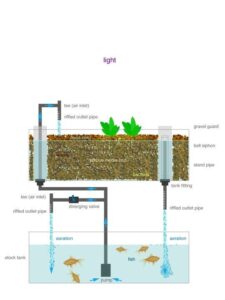Inside the science of a sustainable farming method where waste becomes food, and every drop of water counts.

Aquaponics has rapidly gained attention as one of the most innovative, sustainable farming solutions of our time. By merging fish farming (aquaculture) with soilless plant cultivation (hydroponics), aquaponics creates a closed-loop ecosystem where nothing goes to waste. The diagram you see illustrates how this cycle works, showing the elegant balance between fish, bacteria, worms, and plants—all powered by water flow and natural biology.
Let’s take a closer look at how each component plays its role in this harmonious system.
🐟 Step 1: Fish Provide Nutrient Waste
The journey begins in the stock tank, where fish (commonly tilapia, catfish, or carp) live and grow.
- As fish eat, they produce waste rich in ammonia.
- Left untreated, this ammonia would be toxic, but in aquaponics, it is the foundation for plant fertilizer.
- A pump circulates this nutrient-rich water into the grow bed above.
🦠 Step 2: Bacteria Transform Waste into Nutrients
Inside the porous media bed, which is filled with gravel or clay pebbles, live colonies of beneficial bacteria.
- These microbes convert toxic ammonia into nitrites and then into nitrates, which are safe for fish and serve as vital plant nutrients.
- This natural nitrogen cycle ensures that water remains healthy for fish while feeding the plants.
🪱 Step 3: Worms Break Down Solid Waste
The addition of worms in the media bed enhances the system’s efficiency.
- They consume leftover fish waste, uneaten food, and plant debris.
- Worms break down organic matter into vermicompost, releasing extra nutrients like phosphorus and potassium.
- This creates a richer growing environment for plants while preventing sludge buildup.
🌱 Step 4: Plants Filter and Grow
The plants, rooted in the porous media, thrive on the steady supply of nitrates and minerals.
- Leafy greens like lettuce, herbs, and even fruiting plants such as tomatoes flourish in aquaponic systems.
- As plants absorb nutrients, they purify the water, which then flows back down into the fish tank.
- The gravel guard and bell siphon regulate water levels, ensuring the roots get both water and oxygen.
💧 Step 5: Water Returns, Clean and Oxygenated
After passing through the grow bed, the water returns to the fish tank, now stripped of toxic ammonia and filtered by plants and bacteria.
- The system includes aeration pipes that re-oxygenate the water, keeping the fish healthy.
- A diverging valve and outlet pipes help regulate water flow and maintain consistent cycling.
🔄 Why This System Works So Well
Aquaponics mimics natural ecosystems, where plants and animals live in constant exchange. Its strength lies in balance:
- Fish feed the plants with their waste.
- Bacteria convert waste into plant-usable nutrients.
- Plants clean the water for fish.
- Worms recycle debris, preventing pollution.
This creates a self-sustaining food production system that requires minimal inputs and produces both protein (fish) and vegetables.
🌎 Environmental and Social Benefits
- Water Efficiency: Uses up to 90% less water than traditional farming.
- No Chemicals Needed: Natural nutrient cycling eliminates the need for synthetic fertilizers.
- Year-Round Food Production: Can be operated indoors, on rooftops, or in greenhouses.
- Urban Farming Solution: Perfect for cities where space and soil are limited.
🧪 In Summary
The aquaponic system in the diagram is a blueprint for sustainable farming. Every element—fish, bacteria, worms, plants, and even engineered parts like pumps and siphons—works together in a cycle of growth and renewal.
It’s a living demonstration of how biology and engineering can be combined to solve some of today’s biggest challenges: food security, water conservation, and sustainable development.